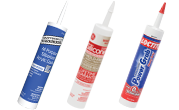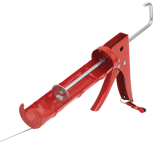Caulk Buying Guide
Cracks and gaps along baseboards, windows, doors, and ceiling trim need to be properly sealed prior to painting. Caulking gives you a smooth edge and a clean professional look. Caulking also reduces airflow around doors and windows to save energy, prevent water leaks, and block out insects.
Caulking Tips
No matter where you're caulking, it's important to get a smooth, even bead across the surface. Cut the tip straight across or at a slight angle, but don't make the opening too big. The tip opening should be slightly smaller than the bead size you need. Using painter's tape will help you control caulk lines and get a cleaner edge. Caulk small sections at a time and continuously keep the caulk moving for an even bead.

Selecting the Right Caulk
Knowing which type of caulk you need will save time and improve results. Selecting caulk will depend on the area you are planning to repair; some types of caulks are paintable while others are better for sealing around plumbing fixtures, or windows. Here are the types of caulks, their benefits, and where best to use them:
Latex Caulk
For painting purposes, a quality latex caulk or siliconized latex caulk is the best choice. Sometimes referred to as "painter's caulk", these caulks are ideal for sealing interior windows, doors, and trim, and for filling small cracks and holes in drywall or baseboards.
Benefits of latex and siliconized latex caulk:
- Can be painted
- Flexible and easy to apply
- Use indoors or outdoors
- Cleans up easy with soap and water
- Can be applied on porous or nonporous surfaces
Silicone Caulk
Silicone caulk is designed to seal gaps around bathtubs, showers, toilets, sinks, and countertops. Most silicone caulk is not paintable and not recommended for filling cracks or spaces around walls and doors.
Benefits of silicone caulk:
- More durable and flexible than latex
- Mildew resistant
- Works best on nonporous surfaces
- Works well in spaces that expand and contract
Latex Sealant
Latex sealants protect exterior surfaces from the elements. Latex sealants are paintable, durable, and flexible enough to withstand expansion and contraction without cracking or losing its seal.
Benefits of latex sealants:
- Waterproof
- Paintable
- Mold and mildew resistant
- Cleans up easily with soap and water
Adhesive Caulk
Formulated like an adhesive and sealing like a caulk, adhesive caulk is designed to adhere to tile, metal, wood, sheetrock, and masonry.
Benefits of adhesive caulk:
- Paintable
- Highly elastic
- Mildew resistant
- Strong gripping power
- Easy cleanup
Caulking Guns

A caulking gun is the most common way to apply caulk inside or out. Caulking guns provide a more continuous bead. Look for guns with a built-in tip cutter and cartridge piercer to make caulk application fast and easy. For smaller jobs, a squeeze tube like the DAP Alex Fast Dry Caulk Plus is simple way to fill in holes and cracks. Because caulk is applied by hand, it's important to maintain a steady pressure. Cartridges generally hold 9-11 ounces of caulk, while tubes hold 3-6 ounces.
For best caulking results:
- Remove loose or old caulking with a sharp utility knife, scraper, or putty knife
- Don't overdo it—only apply what you need
- Apply at a 45° angle and smooth out with your finger
- Clean up any excess right away
Caulking in Cold Weather
Use a high performance silicone caulk when temperatures are cold. Latex caulking will freeze, and should only be used when temperatures are between 40°F to 80°F. Keep tubes of caulking warm, by storing them indoors. Cold caulk will not flow smoothly, and may not seal or fill as expected.


